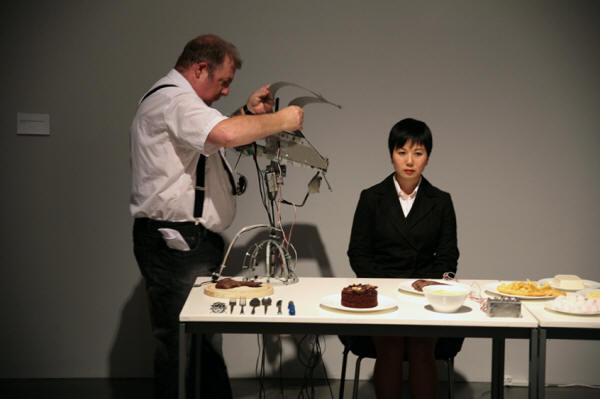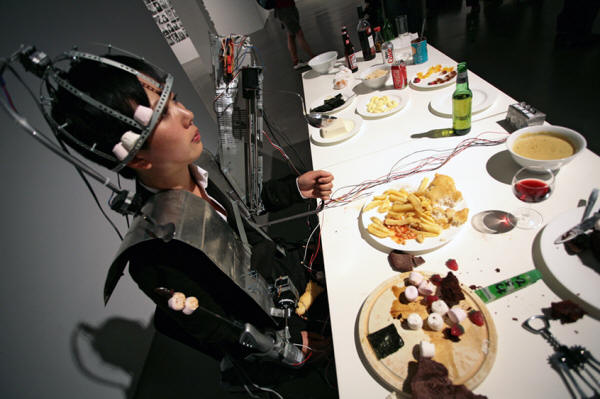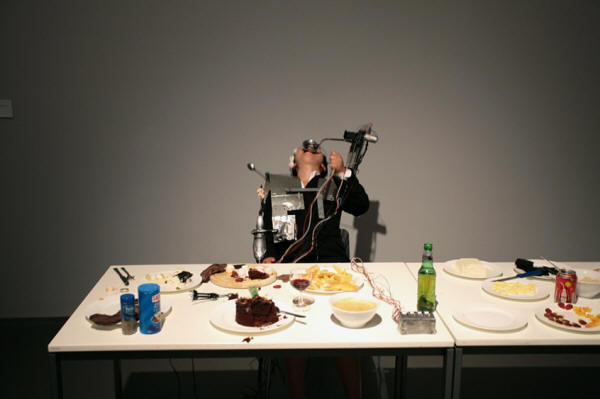|
|
| home | features | exhibitions | interviews | profiles | webprojects | gazetteer | links | archive | forum |
|
The chicken soup was cold A reaction to a performance of Anti-Coolís 'The Last Supper' by Dr Sarah Warwick. The Last Supper was Performed as part of 'Fluxus Now', a symposium organised to coincide with Tatsumi Orimotoís solo exhibition at The Exchange, Penzance.
I am a General Practitioner who attended a performance of Anti-Coolís 'Last Supper' at The Exchange Gallery in Penzance in September 2010. Over the hour of the performance I was moved to anger, made to laugh, found myself frustrated and was close to tears. I was also reminded of aspects of my medical practice. This is a description of what I saw and felt, with an attempt to analyse why the work affected me in the way it did. The performance took place in the main Gallery, surrounded by Tatsumi Orimotoís photographs. There had previously been a discussion around the importance of his motherís dementia in his life and work. Anti-Coolís presence had been arranged as part of a symposium ďFluxus NowĒ which had also led from Orimotoís exhibition. Participants in the symposium, including myself, had just listened to an academic lecture on the development of Fluxus ideas since the foundation of the movement in the 1960's. We left the side room for the more informal space of the gallery. A table was arranged with a selection of food and drink, including both traditional British foods such as fish and chips and chicken soup, and Japanese staples like tofu and soy sauce. The artist entered in a dark, formal suit and high-heeled shoes. She sat on a chair behind the table and a metallic jacket was placed on her shoulders and fixed to her head.We were shown how three buttons on the table controlled three movements by the robotic contraption. The first moved a teaspoon laterally into the artistís mouth where it remained for a few seconds before returning to the side. The second moved a ladle from chest height to the level of the artistís lips. The third operated an arm-like extension bearing an automatic carving knife which moved up and down over a breadboard placed on the table as it whirred into action. Without words we were invited to interact with the display through the food and buttons. Throughout the performer registered no emotion, but ate or drank whatever reached her mouth.
The performance lasted for about one hour while members of the audience took turns in approaching the table. There was a feeling of ritual as we all shared a common point of gaze, interest and thought. In general people took turns, with a respectful pause between each interaction, or a drawing back if two people moved forward together. Some were responses to previous acts by another audience member, for example there was a run of actions trying to solve a specific problem regarding getting a marshmallow to stay on the teaspoon. The first attempt it just fell off. It appeared unstable and too large to get into the performer's mouth. Several attempts were made to cut the sweet. It became a group effort to solve an engineering problem. The final comment in this exchange was made by the person who simply picked up the delicacy and placed it directly in the artistís mouth, bypassing the machinery completely. One member of the audience was interested in exploring the boundaries of the work. He played with the food, using it to decorate the metal jacket rather than using it as nourishment. He then removed the artistís shoes and prepared to cut them with the electric knife. A gallery attendant intervened, but there was also an outcry from several in the audience who expressed discomfort at what was felt to be disrespect for the artist and the work. The interloper responded by kissing the artist on the cheek to even more complaints from other viewers. Some played with the process, for example could the knife cut the provided cake into neat slices? Some explored ideas of taste, mixing sweet and sour; or texture, how seaweed leaves behaved differently in the machine to tofu or chocolate cake. Some responded to the person behind the machine directly, cleaning the spoons between tastings or wiping drips from the artistís face. The audience members whispered among themselves, some trying to get others to do the actions they wished performed, some trying out ideas verbally before committing themselves to action, others criticising the choices of others. Several talked of eating or drinking the food themselves, at least one using the action of filling the artistís spoon as an excuse to steal food from the table. Meanwhile the artist remained apparently unmoved. She responded by attempting to eat all that reached her mouth. In order to drink or eat the contents of the ladle she had to throw her whole trunk violently backwards: an effort that contrasted greatly with her general stillness and passivity. At the end the attendant removed the jacket and she walked away, still poised, silent and unreacting.
There was an increasing feeling of being part of an involved group, not just passive observers. We bonded with laughter, began to share goals as we collaborated in problem solving, started to define rules as in the respectful turn-taking and the insistence of some that the parameters of play were with the machineís defined actions rather than with the role of the artist as artist. There were examples of Tuckmanís stages in team development: forming, storming, norming and eventually performing. At the time I just felt more involved on a social as well as a personal level. As the time progressed, my initial interest in the machine and its possibilities gave way to thoughts about the person behind the machine. The metal helmet and buttons had made me think of medical equipment, in particular EEG (electroencephalograph) machines that are used to display brain waves and aid diagnosis of epilepsy. It is easy in my profession to allow tests and results to obscure the reality experienced by the patient. I remember avoiding being linked to a foetal heart recorder during my own labour as I had so often seen staff and husbands watch the monitorís screen rather than the face of the woman in labour. In addition the sheer effort required of the artist in getting the food from the machine to her mouth was immense. To get food from the teaspoon she needed to coordinate with its painfully slow progress. To get food or drink from the ladle her whole upper body had to swing back, almost overturning the chair in which she sat. The machine, designed to feed, forced a visible disability on her which she had to work hard to overcome. Following on from the recognition of the person behind the machine came frustration at how the imposed situation limited communication. The desire to use the food as a comfort or a form of care could not be met within the constraints of the performance. Did she want British or Japanese diet? Although we had the power to choose for her, we were impotent in this respect, and never able to know whether it was the choice she would have made for herself.
By now the work was reminding me of scenes I frequently view in old peopleís homes, where residents, unable through age or disability to communicate their preferences, are fed what others think they will enjoy. I remember a scheme in Manchester where a specific Afro-Caribbean day centre was set up that could provide participants with the tastes of their youth. I remember a ward for the elderly where everyone was given sugar in their tea. And so to tears. I am surrounded by Orimotoís photographs which comment on the life he shares with his mother and her Alzheimerís. I now think of the title of the piece. Do we ever know when our own last supper will occur? For someone living in a nursing home, that last supper is close and, unlike the condemned man who is traditionally given a choice for his last meal, control over the content is in the hands of others. The Christian connotations of the last supper reverberate, but instead of the communion of the communal shared meal I think of the sponge soaked in vinegar which was the last he received on the cross. Was receiving that a comfort or a torture? The work spoke to me of power and control, torture and compassion, seeing and failing to see humanity, being part of a social group and sharing experience, and ideas with others. It referred to choice and its absence, uncertainty of the future, the experience of disability and old age. After the event I heard the artist complain that the chicken soup which she had heated prior to the event was cold by the time she drank it. How often is this the experience of the elderly who are fed soft foods to overcome eating difficulties only to find the fluids made tepid or cold to avoid scalding?
photography by Graham Gaunt. For more images go to www.artsurgery.org |
|
|



